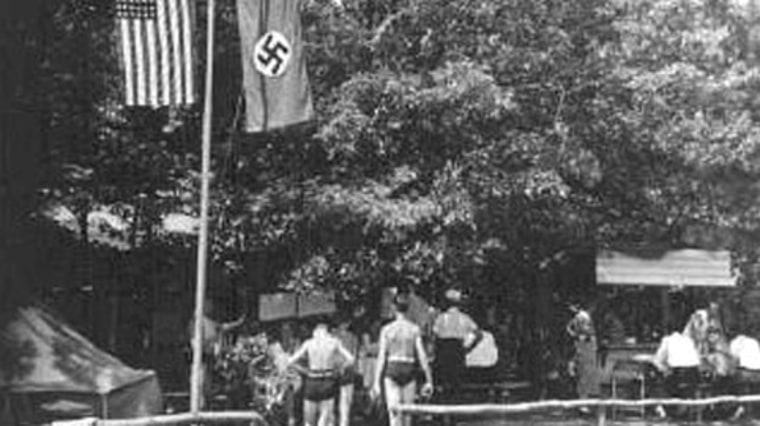After the stock market crash in 1929, thirteen million people were out of work. This triggered the Great Depression, which lasted through the late 1930s. The worldwide economic devastation that ensued fostered a climate of racial and ethnic tension both in the U.S. and Europe. Between 1933 and 1945, Nazism in Germany gained currency, as people tried to place blame on others for the global economic depression. The beliefs were embraced by some Americans, and Nazi factions arose in the U.S. One such party, the German-American Bund, which thrived during the mid-1930s, openly espoused Nazi ideology.
Jews did not fit easily into U.S. "racial" groups or within the black-white dichotomy. Yet from the white viewpoint, Jews were racially different, set apart by their non-Christian religious customs, urban neighborhoods, professional endeavors and preference for marrying other Jews. However, Jews did not conform to the stereotypes many in the U.S. had about racial minorities. Although there were many poor Jews who immigrated to America after 1880, many others were economically successful and upwardly mobile merchants and tradesmen. While whites found Jews racially different from themselves, they were somewhat more accepting of Jews than they were of African Americans. Still, many Jews perceived the racial bias and tried to conform to American standards of “whiteness” by Anglicizing their names and customs with varying degrees of success. They also confronted quotas in many of America’s most prestigious universities that limited the admission of Jewish students.
Franklin Delano Roosevelt’s New Deal economic recovery programs of the 1930s, which included employment and public works projects, were not uniformly administered. Many racial and ethnic groups including blacks, Mexican Americans and Chinese Americans were unable to take advantage of New Deal programs because of discrimination and citizenship requirements.
After the Japanese bombed Pearl Harbor on December 7, 1941, and the U.S. declared war on Japan, the U.S. intervened in the conflict in Europe helping to defeat Germany in World War II.
The Zoot Suit riots in Los Angeles, California, in June 1943 were racially motivated conflicts involving World War II soldiers and sailors in Los Angeles and Mexican American “pachucos”—city youths who identified themselves by the zoot suits they wore. While smaller scale altercations had previously occurred between servicemen and the pachucos, on June 3, 1943, several servicemen on leave alleged that they had been attacked by a group of pachucos. In retaliation, they convened in downtown and East Los Angeles, the center of the Mexican community, and indiscriminately assaulted zoot-suited men, stripping off their clothing and burning it. Accounts of police intervention showed a racial bias against Mexican American youths, as well as African American and Fillipino bystanders, many of whom were arrested for disturbing the peace. The rioting continued until military authorities finally intervened on June 7; nine servicemen and several hundred pachucos were arrested. While eight of the soldiers were released without charges (the ninth paid a fine), many of the jailed Mexican American youths were critically injured and died in jail from lack of medical care. Many others were unjustly convicted.
In 1944, Swedish economist Gunnar Myrdal published a study of race in America titled, An American Dilemma: The Negro Problem and Modern Democracy. An estimated six million Jews were killed in World War II. After the war, many European Jews immigrated to the U.S. and to Israel, a newly created Jewish state.
Also during World War II, Japanese Americans were stripped of their rights and confined to internment camps for the duration of the war. By contrast, German Americans and Italian Americans were never stripped of their rights, despite the fact that America was at war with Germany and Italy.
